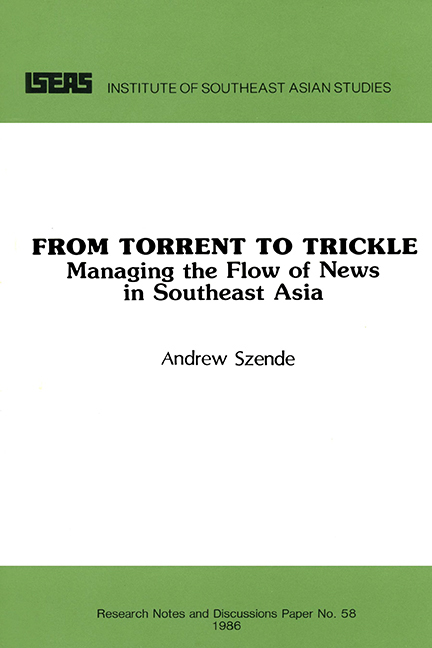Book contents
- Frontmatter
- Contents
- LIST OF TABLES
- Acknowledgements
- PART 1 INTRODUCTION
- PART 2 PERCEPTIONS
- IV The Dilemma of the ASEAN Exchange
- V News Samples in ASEAN
- VI Perceptions of Coverage in ASEAN
- VII Regional Coverage in ASEAN
- PART 3 CONCLUSION
- APPENDIX A
- APPENDIX B
- APPENDIX C
- APPENDIX D
- APPENDIX E
- APPENDIX F
- BIBLIOGRAPHY
- THE AUTHOR
IV - The Dilemma of the ASEAN Exchange
from PART 2 - PERCEPTIONS
Published online by Cambridge University Press: 21 October 2015
- Frontmatter
- Contents
- LIST OF TABLES
- Acknowledgements
- PART 1 INTRODUCTION
- PART 2 PERCEPTIONS
- IV The Dilemma of the ASEAN Exchange
- V News Samples in ASEAN
- VI Perceptions of Coverage in ASEAN
- VII Regional Coverage in ASEAN
- PART 3 CONCLUSION
- APPENDIX A
- APPENDIX B
- APPENDIX C
- APPENDIX D
- APPENDIX E
- APPENDIX F
- BIBLIOGRAPHY
- THE AUTHOR
Summary
While there are various sources of ASEAN news in the region, there is one source that stands out and requires special examination: the news exchange run by the government-owned news agencies which was started in response to the perceived inadequacy of the coverage that was available from the other sources. In a way, the exchange is a child of the international debate about the flow of news: it is ASEAN's demonstrated contribution to a New World Information Order. As such, it is facing the fundamental dilemma of a news service that is at the same time trying to serve two apparently incompatible “masters”: the governments, whose financial support keeps the four national news agencies operating, and the newspapers, whose decisions to use or ignore the ASEAN exchange copy is crucial to the eventual success or failure of the exchange. This chapter examines some aspects of that dilemma, by considering the background, objectives and operation of the news exchange as well as ASEAN perceptions about its contribution to the development of ASEAN and its future prospects.
The exchange began in 1975 as an arrangement between Antara and Bernama. Since Indonesia and Malaysia share a common racial stock in the majority of their populations, officials of both news agencies felt that they could offer stories of common interest to readers in the two countries. Furthermore, since the confrontation between them had been over for nine years, and the two countries had been partners in ASEAN for eight years, the news agency officials felt that it would be appropriate to start some kind of bilateral co-operation. Although the exchange was only between the two agencies, the two governments gave their blessings and encouraged it as a useful manifestation of ASEAN co-operation.
But there were also ideological reasons for the commencement of the exchange. The officials resented the foreign domination of the news flow between their two countries. They felt that some of this news was irrelevant from their point of view, often distorted, often emphasizing what might be of interest only to the developed countries.
- Type
- Chapter
- Information
- From Torrent to TrickleManaging the Flow of News in Southeast Asia, pp. 37 - 52Publisher: ISEAS–Yusof Ishak InstitutePrint publication year: 1986



